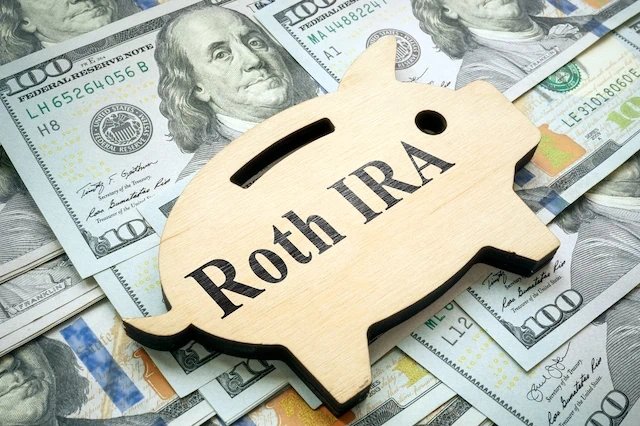Whether your retirement plan is to save just enough to live frugally, or you have far more lavish retirement goals, it’s important to start investing for your post-career life as soon as possible.
To start, you might be asking yourself, “Where should I put my retirement money?” That’s a legitimate question, since there are several good options.
If you work for a company that offers a 401(k) retirement plan, maxing out this plan might seem to be the obvious choice—but is it? Well, it depends. While you definitely want to take full advantage of any matching contributions from your employer, it often makes sense to put any additional retirement savings elsewhere.
Read on to learn more about 401(k)s, employer matches, and other retirement savings alternatives. We’ll also recommend an optimal order for the various retirement savings options, so you can get a sense of the best way to allocate your money. By investing smartly, you can reach your retirement savings goals.
Table of Contents
What Is a 401(k) Plan?

A 401(k) plan is a tax-advantaged account offered by businesses to help eligible employees save money for retirement. Employees who choose to participate in the plan can contribute to their personal 401(k) account, up to the annual contribution limit.
For 2023, the annual limit for most people is $22,500 ($23,000 in 2024). However, if you’re at least 50 years old, you can contribute an additional $7,500 in “catch-up” contributions, for a total of $30,000 ($30,500 in 2024).
There are two types of 401(k) plans: traditional 401(k) plans and Roth 401(k) plans. The main difference between the two is when you pay taxes on the money in the account.
Traditional 401(k) Plans

With traditional 401(k) plans, “pre-tax” income is deposited into your account. In other words, contributions to your account aren’t included in taxable income, so they’re made before income tax is imposed on those funds. Money in the account grows tax-free, but tax is eventually paid when you withdraw funds from the account.
Young and the Invested Tip: People are often in a lower federal tax bracket once they retire. If that’s what you expect, deferring taxes to retirement with contributions to a traditional 401(k) account can save you money. Instead of paying taxes while you’re still working at a higher rate when you put money in the account, you can wait to pay them at a lower rate when you withdraw money from the account in retirement.
The IRS wants you to use 401(k) funds for retirement. As a result, in addition to any income tax due, money taken out of a traditional 401(k) before you turn 59½ years old is generally subject to a 10% penalty when it’s withdrawn (although there are exceptions). Once you turn 59½, there’s no penalty, but distributions are still taxed as ordinary income.
When you turn 73, you must begin taking a certain amount of money out of a traditional 401(k) each year if you haven’t already started. These withdrawals are called required minimum distributions (RMDs). Beginning in 2033, RMDs won’t be mandated until you turn 75. (Before 2023, RMDs kicked in when you turned 72.)
Roth 401(k) Plans

Contributions to a Roth 401(k) account are made with “after-tax” dollars. There’s no deduction from taxable income or other tax break for contributions to a Roth 401(k) plan, so you pay tax on the amount contributed in the year the contribution is made. As a result, contributions are effectively made after income tax is paid on the deposited funds. However, once that money is in your Roth 401(k), it grows tax-free, and you don’t pay any tax when you withdraw the funds in retirement.
With a Roth 401(k), you can withdraw your contributions at any time without having to pay tax or the 10% early withdrawal penalty. However, income tax and the 10% penalty generally apply to earnings taken out of the account if you aren’t 59½ years old or the account isn’t at least five years old.
Currently, RMDs from a Roth 401(k) account are generally required once you hit your 73rd birthday. However, starting in 2024, RMDs will no longer be required from Roth 401(k) accounts.
Related: IRA Contribution Limits for 2024 [Save More in ’24]
How Do Employer Matching Contributions Work?

As an extra benefit, some companies offer an employer match with their 401(k) plan. In other words, in addition to whatever you put in your 401(k) account, the company will also put money in your account. This is an extra benefit that is often used to attract talent.
Many different formulas can be used to calculate an employer match. For example, employers that offer matching 401(k) contributions sometimes contribute a predetermined amount based on the employee’s annual contribution—say, a dollar-for-dollar match for the first $2,000 an employee contributes to his or her own 401(k) account each year. If that’s the case, there’s no employer match if you don’t contribute to your account.
Related: 401(k) Contribution Limits for 2024 [Save More in 2024]
Another popular method is to match a percentage of the employee’s contributions, up to a designated portion of the worker’s total salary. For example, your employer might match 50% of your 401(k) contributions, up to 5% of your annual salary. If you earn $70,000, your contributions up to $3,500 (5% of your salary) are eligible for the employer match. Since the employer matches 50% of your contributions, its match is capped at $1,750 ($3,500 x .50).
Although rare and technically not a “match,” some employers even contribute to their workers’ 401(k) accounts without requiring employee contributions.
Related: Best Vanguard Retirement Funds for a 401(k) Plan
No matter which system is used, an employer contribution is considered “free money” because the employee doesn’t have to work any additional hours for the extra money in their accounts. This, of course, makes it much easier to reach your retirement savings and financial goals.
Young and the Invested Warning: You might not be able to keep the employer match (or all of it) if you don’t work at the company very long. Money you put into your own 401(k) account is yours from the get-go. However, under some 401(k) plans, employer matches aren’t fully “vested” until you’ve been with the company for a certain number of years (e.g., the employer match will be yours to keep once you’ve worked at the company for five years).
Related: How to Get Free Money Now
Limits on Company Matches

In addition to the limit on the amount you can put into 401(k) plans for the year, there’s also an overall maximum amount that can be contributed to all of your accounts in plans maintained by one employer. That limit includes both your contributions and any employer matches.
Related: 7 Best Fidelity ETFs for 2024 [Invest Tactically]
For 2023, the total maximum allowed is $66,000 ($73,500 for people 50 or older making catch-up contributions). In 2024 that number rises to $69,000 and $76,500 for people 50 and older.
Related: Best Schwab Retirement Funds for a 401(k) Plan
How Much Should You Contribute to Your 401(k) Plan?

There isn’t a one-size-fits-all answer to how much a person should contribute to a 401(k) plan because several factors are at play. One of the main factors is whether or not you get matching employer contributions and, if so, how much.
If your employer provides a matching contribution, you should at least contribute enough to get the maximum match so you don’t miss out on that “free money.”
Related: 9 Monthly Dividend Stocks for Frequent, Regular Income
After that, your optimal contribution amount will depend on your current financial situation and your retirement goals. For instance, when deciding how much to put in your 401(k) plan, you’ll certainly need to consider the lifestyle you desire in retirement, but you should also factor in current expenses for necessities, any debt you owe, whether you have an emergency fund, and the like.
You’ll want to look at other options, too. For instance, can you get a better return on your investment by putting your money elsewhere? There are other types of retirement accounts available (more on them in a minute)—maybe you’ll be better off putting some of your savings in an alternative retirement account.
Related: 5 Best Vanguard Retirement Funds [Start Saving in 2024]
Is Maxing Out Your 401(k) a Good Idea?

For 2023, you can stuff up to $22,500 in your 401(k) plan ($23,000 in 2024)—$30,000 if you’re at least 50 years old ($30,500 in 2024). But is it wise to max out 401(k) plans every year?
Related: 401(k) Contribution Limits for 2024 [Save More in 2024]
Again, it depends on your own financial situation, plans for retirement, and other options available. Maxing out your 401(k) might not be feasible or other investment options might be better. So, don’t automatically assume that maxing out your 401(k) plan is the way to go.
Related: The 9 Best Dividend Stocks for Beginners in 2024
Where Else Can I Put My Retirement Savings?

Many people don’t have a job that offers a 401(k) plan. Plus, even if you have access to a 401(k) plan, you might need to save more than what’s possible with a 401(k) account to reach your retirement savings goal.
Related: Best Fidelity Retirement Funds for a 401(k) Plan
Here are a few other places where you can park money you’re saving for retirement.
1. Traditional IRAs

A traditional individual retirement account (IRA) is another type of tax-deferred retirement savings account. For 2023, you can contribute up to $6,500 ($7,000 in 2024) to any number of IRAs (people 50 or older can contribute $1,000 more). If you have less than $6,500 of earned income ($7,000 in 2024), your contribution is limited to the amount you actually earned that year.
Related: Best Fidelity Retirement Funds for an IRA
As with a traditional 401(k), you put money in a traditional IRA on a “pre-tax” basis, thanks to a tax deduction for your contributions. Note, however, that the deduction is subject to income limits if you (or your spouse if you’re married) is covered by an employer-sponsored retirement plan (e.g., a 401(k) plan).
Related: 9 Monthly Dividend Stocks for Frequent, Regular Income
When you withdraw funds from a traditional IRA after age 59½, the money is subject to federal income tax. However, if you pull money out of a traditional IRA before reaching age 59½, that money is generally subject to a 10% early withdrawal penalty (there are exceptions), in addition to regular income taxes.
As with traditional 401(k) accounts, you must start taking RMDs from a traditional IRA when you turn 73.
Related: Retirement Plan Contribution Limits and Deadlines for the 2023 Tax Year
2. Roth IRAs

A Roth IRA is a tax-advantaged retirement account funded with “after-tax” dollars. The combined contribution limit for Roth IRAs and traditional IRAs for 2023 is $6,500 ($7,500 if you’re at least 50 years old). (For 2024, these numbers are $7,000 and $8,000, respectively.) However, you can’t contribute more money than you earn in a year, so if your earned income is less than $6,500, that number is your IRA contribution limit.
Related: Best Vanguard Retirement Funds for an IRA
As with a Roth 401(k), there are no tax advantages for a Roth IRA in the year you contribute to the account. Instead, since the money has already been taxed, you don’t pay any additional tax when you take qualified distributions during retirement. As a result, Roth IRAs are an excellent choice for anyone who expects their income tax rate in retirement to be higher than their current rate.
Related: 12 Best Long-Term Stocks to Buy and Hold Forever
Contributions to a Roth IRA can be withdrawn at any time tax-free and without any penalties. However, if you want to withdraw earnings without owing a 10% early withdrawal penalty, you generally need to wait until age 59½ and have a Roth IRA that is at least five years old.
RMDs aren’t required for Roth IRAs.
Income Limits on Roth IRAs

There are income limits for a Roth IRA, so not everyone can contribute to one (or contribute the full amount). For the 2023 tax year, the $6,500 or $7,500 Roth IRA contribution limit is gradually reduced to zero if your modified adjusted gross income (MAGI) falls within the following range ($7,000 and $8,000, respectively in 2024):
— $138,000 to $153,000 for single and head-of-household filers ($146,000 to $161,000 in 2024)
— $218,000 to $228,000 for married couples filing a joint tax return ($230,000 to $240,000 in 2024)
— $0 to $10,000 for married people filing a separate tax return
Related: Best Schwab Retirement Funds for an IRA
Workers earning less than the income limit can contribute to a Roth IRA at any age, so even children can open a Roth IRA as long as they have earned income during the year.
Related: Best Vanguard Retirement Funds for an IRA
3. Health Savings Accounts

A health savings account (HSA) is a tax-advantaged savings and investment account you can use to cover qualifying medical costs such as copays, prescriptions, over-the-counter drugs, medical supplies, and more.
Related: Best Vanguard Funds to Hold in an HSA
For 2023, you can contribute up to $3,850 to an HSA if you only have health insurance coverage for yourself ($4,150 in 2024). The maximum contribution is $7,750 if you have family coverage ($8,300 in 2024). You can contribute an additional $1,000 in “catch up” contributions if you’re at least 55 years old by the end of the year.
Related: HSA Contribution Limits for 2024 + 2025
Triple-Tax Advantage on HSAs

Some people have an account through their employer, while other workers, such as freelancers, can open their own HSA. For employer-sponsored accounts, contributions are made with “pre-tax” income. For non-employer accounts, any money contributed can be deducted from that year’s taxable income. In either case, money in an HSA grows tax-free.
Related: Best Fidelity Funds to Hold in an HSA
You can also take tax-free withdrawals from an HSA if the money is used for qualified medical expenses. Money taken out of an HSA that isn’t used for qualified medical expenses is subject to income tax and a 20% penalty. Fortunately, there’s a wide range of products that you’re allowed to purchase with HSA funds, including common household medical items, such as bandages.
However, once you reach age 65, money can be withdrawn for any purpose with no penalty (although it will be subject to income tax). You’re never required to take distributions (i.e., RMDs), either. For these reasons, HSAs are often used for retirement savings.
HSA Eligibility and Contribution Limits

Not everyone can contribute to an HSA, though. You’re only eligible if you don’t receive Medicare, aren’t covered under any disqualifying health coverage, and aren’t claimed as a dependent on someone else’s tax return.
Related: Best Schwab Funds to Hold in an HSA
You also must be enrolled in a high-deductible health plan (HDHP). For 2023, HDHPs must have a minimum deductible of $1,500 for individuals or $3,000 for families ($1,600 and $3,200 in 2024, respectively). Your out-of-pocket medical expenses under the HDHP also can’t exceed $7,500 for self-only coverage or $15,000 for family coverage for 2023 ($8,050 and $16,100 in 2024, respectively).
4. Taxable Brokerage Accounts

A taxable brokerage account is a flexible investment account that you control. Users can buy and sell common investments, such as stocks, bonds, and exchange-traded funds (ETFs) with very few restrictions. To open an account, you just need to be an adult and have a Social Security number or tax ID number.
A benefit to taxable brokerage accounts is that there are no contribution limits. Additionally, the money is extremely liquid and can be withdrawn at any time with no penalties.
The downside to taxable brokerage accounts is clear from the name—you have to pay taxes on capital gains and interest earned. The amount you pay in taxes depends on your income and whether it was a long-term (over a year) or a short-term investment.
Related: 7 Best Schwab ETFs to Buy [Build Your Core for Cheap]
If I Have Limited Funds to Invest, How Should I Invest For Retirement?

Retirement savings can be a challenge, but it’s never too late to start. Even small contributions can make a big difference over time. If you’re struggling to save, here are some general tips to get you started.
Remember, everyone’s financial situation is unique. Consulting with a financial advisor can provide personalized guidance tailored to your specific goals and circumstances.
Like Young and the Invested’s content? Be sure to follow us.
1. First, Max Out 401(k) Employer Match

Always prioritize your employer’s 401(k) match. This is like free money! It boosts your retirement savings and can even double your contributions. Don’t miss out on this opportunity.
2. Contribute to a Health Savings Account

If you don’t qualify for an HSA, you should skip this step. However, if you’re insured under a qualified high-deductible health plan and can contribute to an HSA, this should be your next course of action.
The reason contributing to an HSA should be your next priority after a 401(k) match is because it offers so many tax advantages.
Contributions are either not subject to tax or tax-deductible (depending on if you got the HSA through an employer or on your own), earnings grow tax-free, and there are no taxes when you withdraw either if you wait until you’re at least 65 years old.
As a bonus, if you have a medical emergency, you can tap into those funds at any time with no penalty. Unfortunately, HSA contribution limits are low, so HSAs aren’t sufficient as one’s sole plan for retirement savings.
Related: How Are Social Security Benefits Taxed?
3. Contribute to an IRA

IRAs don’t offer as many tax advantages as HSAs, which is why they rank lower than HSAs on our list. Still, they do offer some tax benefits. With Roth IRAs, your earnings grow tax-free, but there’s no tax break when you contribute to the account. Contributions to a traditional IRA are generally deductible, but taxes on contributions and earnings are only deferred until retirement.
Note that your MAGI must be less than $153,000 (individual) or $228,000 (married filing jointly) to contribute to a Roth account for the 2023 tax year ($161,000 and $240,000 in 2024, respectively). If you make more than this amount, skip this step. There is no income limit for a traditional IRA, but there are limits for your deductible contributions.
401(k) plans typically offer fewer investment options than IRAs and often charge higher fees. So, it’s often better to contribute to an IRA before maxing out a 401(k) to take advantage of the ample investment choices and possibly lower fees.
Related: IRA Contribution Limits for 2024 [Save More in 2024]
4. Max Out Your 401(k)

Once you’ve maxed out your employer match, and contributed to an HSA, IRA, consider contributing as much as possible to your 401(k). This can reduce your current taxes, as 401(k) contributions are pre-tax.
If you think your tax rate will be higher in retirement, a Roth 401(k) might be a better option. Roth contributions are made with after-tax dollars, but withdrawals are tax-free in retirement.
Related: Best Apps That Give You Money for Signing Up
5. Pay Off High-Interest Debt

All debt is not created equal. High-interest debt, such as credit card debt, should be a priority to pay off. Low-interest debt, such as a mortgage, shouldn’t be prioritized over investments.
Quickly pay off any debt that is at a higher percentage rate than what you can expect to earn through investments. If the interest rate is less than what you expect to earn through investments, continue to make payments, but don’t prioritize extra payments over investments.
Related: Should I Pay Off My Mortgage Before I Retire?
6. Contribute to Taxable Brokerage Accounts

If you’ve maxed out all of the retirement accounts above and still have extra money you can contribute toward retirement, contribute to a taxable brokerage account.
These accounts don’t come with any tax advantages, but strategically invested money can grow far quicker than money in savings accounts. Depending on the investments chosen, they can also create a passive income stream.
Related: The 7 Best Fidelity Index Funds for Beginners
At What Salary Should You Max Out Your 401(k)?

The decision to max out your 401(k) shouldn’t be based on your salary as much as on what other investment options you have utilized and your current financial situation.
After maxing out an HSA (if you qualify for one) and an IRA, it’s wise to max out your 401(k), provided your financial situation allows it. The more money you save for retirement, the better. However, you generally can’t withdraw money in your traditional 401(k) account prior to age 59½ without paying a penalty, so you shouldn’t contribute any money you’re likely to need before then (contributions to a Roth 401(k) can be taken out penalty-free before age 59½).
Assuming you have enough money for all of your expenses, as well as a fully funded emergency account, and you’ve taken advantage of other higher priority investment options, feel free to max out your 401(k).
Related: The 7 Best Vanguard Index Funds for Beginners
Should I Max Out My 401(k) As Soon As Possible?

You’re allowed to make all of your 401(k) contributions early in the year, but just because you can doesn’t necessarily mean it’s the most strategic course of action.
As a general rule of investing, the more time your money is in the market, the better. According to this rule, it would make sense to max out your 401(k) as quickly as you can at the beginning of the year.
However, many people get an employer contribution match that is calculated and funded every pay period. Maxing out your account early in the year could mean you miss out on some of the money your employer would otherwise match if you spaced contributions out throughout the year.
Like Young and the Invested’s content? Be sure to follow us.
Can You Contribute to a 401(k) and an IRA?

Yes, you can contribute to both a 401(k) and an IRA. In fact, if your financial situation allows it, financial advisors typically recommend contributing to both. Just be mindful of the relevant contribution limits.
Related: Roth IRA vs. 529 Plan: Which Is Better For College Savings?
Is It Better to Put Money in Your 401(k) or Invest Elsewhere?

Employees at companies that offer 401(k) contribution matches should always contribute to their 401(k) up to the matching limit. Once that limit is reached, additional money is best contributed to an HSA (for those who qualify) or an IRA.
If you’ve maxed out your HSA and IRA, it’s often better to put more money into your 401(k) before turning to a taxable brokerage account.
Still worried about maxing out your 401(k), then an individual retirement account set up by a financial advisor will help you meet your financial goals. An emergency fund is something else you should consider. But if your annual income for retirement plans at retirement age is high, a tax-advantaged account is good for financial planning purposes.
Want to learn more about investing, spending, taxes, and more? Sign up for Young and the Invested’s free newsletter: The Weekend Tea.





